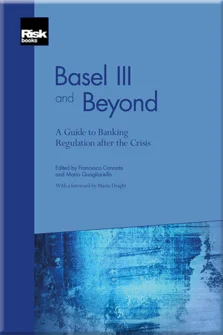A New Framework for the Trading Book
Federico Cabañas
Foreword
Introduction to 'Basel III and Beyond'
The Big Financial Crisis
The Policy Response: From the G20 Requests to the FSB Roadmap; Working Towards the Proposals of the Basel Committee
The New Definition of Regulatory Capital
A New Framework for the Trading Book
Counterparty Credit Risk and Other Risk-Coverage Measures
Tools for Mitigating the Procyclicality of Financial Regulation
The Regulatory Leverage Ratio
The New Framework for Liquidity Risk
The Discipline of Credit Rating Agencies
Systemically Important Banks
Regulating Remuneration Schemes in Banking
Crisis Management and Resolution
The Impact of the New Regulatory Framework
A Brazilian Perspective on Basel III
A New Institutional Framework for Financial Regulation and Supervision
Structural Regulation Redux: The Volcker Rule
The Changing Uses of Contingent Capital under the Basel III Framework

This article was first published as a chapter in Basel III and Beyond on July 27, 2011, by Risk Books.
4.1 Introduction
Throughout 2009 and 2010 most public attention has focused on the completion of the Basel III package of regulatory measures, which were published in December 2010. Basel III raises the resilience of the banking sector by strengthening the Basel II regulatory capital framework.
Traditionally, regulation had been designed with a purely microprudential (institution-specific) perspective and relied almost entirely on individual capital-adequacy indicators. Regulation was constructed mainly around each individual institution’s capital ratio without taking into account a “macro” view (see Chapter 2). The focus on capital also implied that regulation largely ignored other risks, which had no direct impact on losses, such as liquidity.
Basel III does widen the traditional scope of regulation, including for the first time macroprudential elements, such as the introduction of a leverage ratio, a new 2.5% conservation buffer or, for globally systemic banks, establishing additional capital buffers. Basel III also introduces for the first time a global liquidity
Copyright Infopro Digital Limited. All rights reserved.
As outlined in our terms and conditions, https://www.infopro-digital.com/terms-and-conditions/subscriptions/ (point 2.4), printing is limited to a single copy.
If you would like to purchase additional rights please email info@risk.net
Copyright Infopro Digital Limited. All rights reserved.
You may share this content using our article tools. As outlined in our terms and conditions, https://www.infopro-digital.com/terms-and-conditions/subscriptions/ (clause 2.4), an Authorised User may only make one copy of the materials for their own personal use. You must also comply with the restrictions in clause 2.5.
If you would like to purchase additional rights please email info@risk.net











